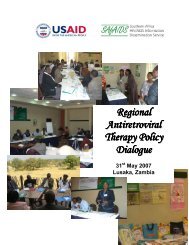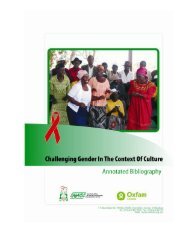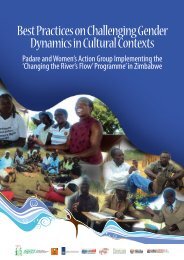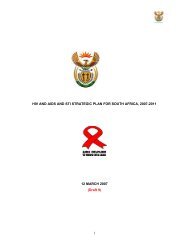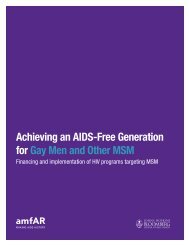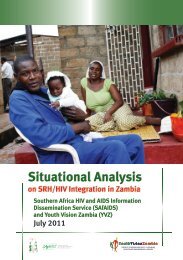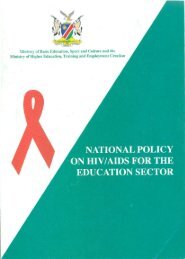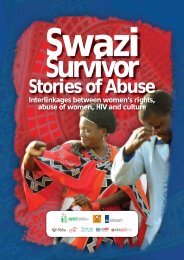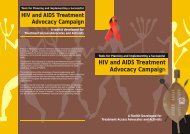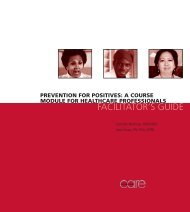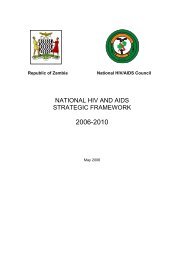Implementation of regional and international HIV prevention - SAfAIDS
Implementation of regional and international HIV prevention - SAfAIDS
Implementation of regional and international HIV prevention - SAfAIDS
- No tags were found...
You also want an ePaper? Increase the reach of your titles
YUMPU automatically turns print PDFs into web optimized ePapers that Google loves.
12.0 CONCLUSIONS AND RECOMMENDATIONS12.1 ConclusionsSwazil<strong>and</strong> <strong>and</strong> Zambia have demonstrated their commitment to be guided by interventionalprinciples by virtue <strong>of</strong> being signatory to major <strong>international</strong> conventions that guide <strong>HIV</strong>responses. Both governments have put in place policies <strong>and</strong> frameworks for domestication <strong>of</strong>these <strong>international</strong> conventions <strong>and</strong> protocols. However, Zambia has not yet made a deliberateattempt to put in place a legal framework that specifically addresses the various protocolsto which the country is a signatory. Many issues core to the declarations are said to beaccommodated in some clauses in other legal sources such as the Constitution <strong>and</strong> statutorylaw. Their accommodation may take the form <strong>of</strong> them being implied as opposed to beingexpress. Putting in place legislation specifically addressing the protocols engenders a rightsbasedapproach to the entire response framework. The need for a rights-based approach wasidentified as an essential element in Swazil<strong>and</strong>.Zambia has made strides in scaling up its response to the <strong>HIV</strong> <strong>and</strong> AIDS epidemic in the areas<strong>of</strong> <strong>prevention</strong>, treatment, care <strong>and</strong> support <strong>and</strong> mitigation. Despite the weaknesses alreadyidentified in the system, Zambia remains an enviable model for the region in the rapid rollout <strong>of</strong> the <strong>HIV</strong> <strong>and</strong> AIDS response from the centre to the periphery, using a multi-sectoralapproach. It is commendable that the <strong>HIV</strong> <strong>and</strong> AIDS Strategic Framework was produced in ahighly participatory manner, using a bottom-up approach. In other words, there was a broadbuy-in from stakeholders. However, one noteworthy element is that the Plan (2006-2010)does not take most <strong>of</strong> its remit from the National <strong>HIV</strong> <strong>and</strong> AIDS Policy. It ushers in some newcourses, obviously to compensate for the gaps in the <strong>HIV</strong> <strong>and</strong> AIDS Policy, <strong>and</strong> is an admissionby planners that the current policy is outdated. Furthermore, there are many current issuesimpacting on the <strong>HIV</strong> <strong>and</strong> AIDS national response that are not addressed such as provision <strong>of</strong>second line medicine when the first regimen <strong>of</strong> ARVs has failed <strong>and</strong> tracking the impact <strong>of</strong>circumcision on the incidence <strong>of</strong> <strong>HIV</strong>.A multi-sectoral approach in planning <strong>and</strong> resource mobilisation was also adopted inSwazil<strong>and</strong>. Strategic planning <strong>and</strong> resource mobilisation <strong>of</strong> <strong>HIV</strong> <strong>and</strong> AIDS interventions areparticipatory in nature. There are systems that allow for the participation <strong>of</strong> the beneficiaries<strong>and</strong> communities in the development <strong>of</strong> sectoral operational programmes that go through thegovernment planning <strong>and</strong> budgeting processes. Priorities related to <strong>HIV</strong> <strong>and</strong> AIDS <strong>prevention</strong>,care <strong>and</strong> treatment are set based on a needs analysis <strong>and</strong> rational policy choices that addressthe needs <strong>of</strong> different segments <strong>of</strong> populations through clearly-outlined strategies. This iscritical in that not only does community ownership <strong>of</strong> interventions improve implementation<strong>of</strong> <strong>international</strong> conventions <strong>and</strong> declarations but rational prioritisation <strong>of</strong> interventions allowsfor efficiency <strong>and</strong> effectiveness in achieving set targets <strong>and</strong> goals in the national <strong>HIV</strong> response.52In Swazil<strong>and</strong>, information dissemination is subdued, despite this being critical for a rightsbasedresponse. For example, stakeholders lamented the inadequate dissemination <strong>of</strong>NERCHA’s reports, especially at levels lower than national level. Although some reportsare available on NERCHA’s website, most stakeholders want NERCHA to be pro-activewith information dissemination. There is huge potential for harmonising interventions <strong>and</strong>increasing co-ordination with the consortia <strong>of</strong> stakeholders working on gender, <strong>HIV</strong> <strong>and</strong>AIDS <strong>and</strong> food security established by CANGO. The starting point will be to develop credibleregisters <strong>of</strong> stakeholders with their response pr<strong>of</strong>iles, <strong>and</strong> to link this to the monitoring <strong>and</strong>evaluation efforts <strong>of</strong> SHAPMoS.



